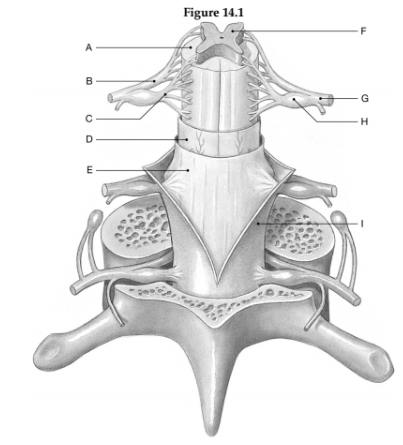Name the major components of a typical vertebra
A) intervertebral discs, intervertebral foramina, and vertebral canal
B) articular processes, vertebral arch, and vertebral body
C) vertebral head, vertebral body, vertebral discs
D) vertebral body, vertebral curves, intervertebral foramina
E) intervertebral discs, intervertebral foramina, vertebral arch
Ans: B) articular processes, vertebral arch, and vertebral body
You might also like to view...
Using the figure above, identify the labeled part.

1. Label A: ______________________________
2. Label B: ______________________________
3. Label C: ______________________________
4. Label D: ______________________________
5. Label E: ______________________________
6. Label F: ______________________________
7. Label G: ______________________________
8. Label H: ______________________________
9. Label I: ______________________________
Match each of the terms with its definition or description.
a. intracellular fluid b. interstitial fluid c. plasma d. ADH e. ANH f. electrolyte g. capillary blood pressure h. plasma proteins i. dehydration j. overhydration k. anions l. aldosterone m. extracellular fluid n. edema o. fluid compartments p. cations 1. _____ Dissociates into ions in a water solution 2. _____ Fluid that is in spaces between the cells 3. _____ A hormone that is made in the pituitary gland and increases water absorption in the kidney 4. _____ Can be the result of prolonged vomiting or diarrhea 5. _____ A hormone that is made in the heart and can increase the amount of water lost in the urine 6. _____ Liquid fraction of whole blood 7. _____ Main water-pushing force moving fluid out of the capillaries 8. _____ Can result if intravenous fluid is administered too rapidly 9. _____ Fluid inside the cells 10. _____ Water-pulling force pulling water back into the capillaries 11. _____ Consists of plasma and interstitial fluid 12. _____ The two examples of these are extracellular and intracellular 13. _____ Term given to negatively changed ions 14. _____ Term given to positively charged ions 15. _____ Tissue swelling as a result of too much interstitial fluid 16. _____ Hormone secreted by the adrenal cortex that increases sodium reabsorption from the kidneys
Which of the following is NOT an adhesive molecule found in the ground substance of connective tissue?
A. Chondroitin sulfate B. Chondronectin C. Osteonectin D. Fibronectin
An offspring of parents whose genotypes are Aa and Aa may be
A. AA, Aa, or aa. B. AA or aa. C. only Aa. D. only aa.